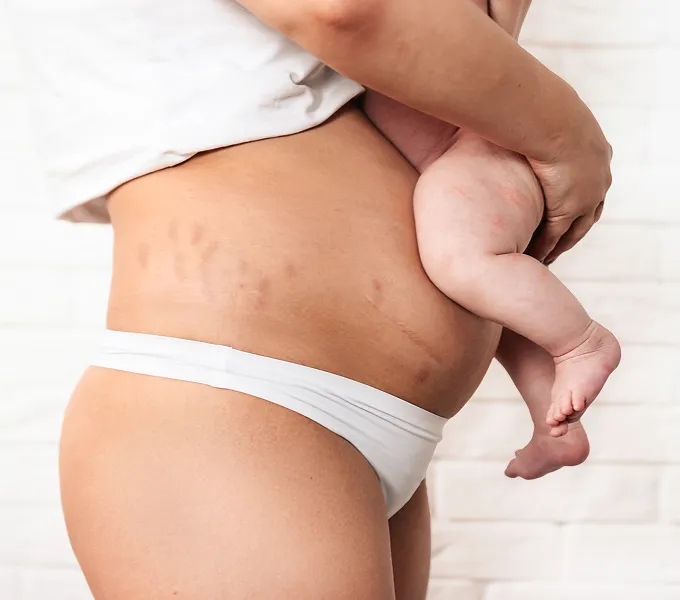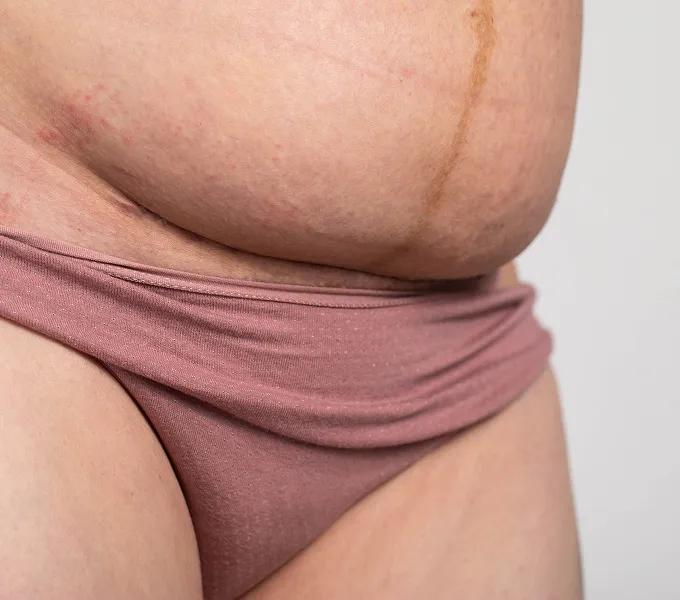
7 Causes of Back Pain After a C-Section & How to Feel Better
If you've recently had a c-section, you're bound to be dealing with aches and pains in your abdomen as your incision heals. When you add back pain to the mix — which happens to 70% of people who give birth via c-section — your daily discomfort can increase exponentially.
You may feel like there's no comfortable way to feed or carry your baby, sleep through the night, or do everyday chores like laundry and dishes. It's no wonder that research has found that back pain after c-section can take a toll on postpartum mental health.
Below, we review 7 common factors that contribute to post-c-section back pain, and provide helpful tips for relieving pain and healing your body.
1. Back pain factor: Inflammation
Not that you want to think about it again, but a c-section involves cutting through seven layers of tissue — including your abdominal muscles and uterus. The healing process following surgery can cause pain and inflammation in your abs and back muscles, as well as nearby tissues.
It's very common to have pain in the areas surrounding your surgery including your pelvis, low back, and abdominals, especially in the early to mid stages of healing.
- Reduce inflammation with ice during the initial days post-surgery and then anytime when pain flares up. A general guideline is to ice your incision or lower back (where ever you're feeling the pain) for 10 minutes, every couple of hours until the pain subsides. Be sure to keep a clean thin cloth between the ice pack and your skin.
- Examine your incision every day. Keep the area clean and dry, and inspect it for any changes such as increased redness, warmth, swelling, or bleeding. If you observe any new or unusual symptoms, contact your healthcare provider immediately.
- Ask your doctor which pain relief meds are best for you. The most commonly recommended pain meds after c-section are Advil, Motrin IB, and Tylenol. These are safe to take when breastfeeding.
2. Back pain factor: Joint-relaxing hormones
During pregnancy, the body releases the hormone relaxin, which loosens ligaments and joints to prepare for childbirth. It can also contribute to developing back and pelvic pain during pregnancy.
This same hormonal change can continue to affect your joint stability postpartum, making it easier to strain your back as you heal from your cesarean.
Pain relief tips:
- Try a core-stabilizing belly band or abdominal binder. Evidence suggests that abdominal binders can reduce distress after a cesarean section and help you become mobile more quickly. There are several different types of abdominal binders on the market. Get recommendations here from our clinical team.
- Check in with a postpartum PT to make sure you're wearing a binder correctly. Overly tight binders can interfere with incision healing, increase pelvic pressure, and potentially worsen pelvic floor dysfunction. A single visit with a PT (consider a virtual visit if moving around is a struggle) can help you understand how and when to wear a binder.
3. Back pain factor: Inactivity
As you heal from a c-section, it’s very common to feel like you should move less and rest more. This may be helpful initially. But after a while, it can lead to stiffness and pain in your back and hips, weakened muscles in your core, and reduced mobility.
Of course, even if you want to move, you may not be able to. Anyone with a newborn knows what it's like to be "nap trapped" with an easily-woken baby who finally falls asleep in your arms.
Pain relief tips:
- Start walking as soon as your doctor says it's ok. Walking helps support healing and reduces pain by improving circulation and reducing swelling. (It also helps stimulate bowel movements.)
- Set a schedule for when you'll walk and, if possible, ask loved ones to be with the baby at those times.
- Take it slow at first and aim for just 5 or 10 minutes at a time, a few times a day. If you feel unsteady on your feet, ask a friend or family member to walk with you. Add time gradually as you feel stronger.
- When you can't walk, try marching in place. Marching is an underrated way to move your body and get your blood flowing.
4. Back pain factor: Scar tissue
As a normal part of healing, your body forms scar tissue to help repair your incision. But it’s also common for this scar tissue to grow deep in your abdomen and form adhesions.
Adhesions are bands of scar tissue that can cause layers of tissue to “stick” together, ultimately impacting their function. Scar tissue and adhesions after abdominal surgeries are known to cause abdominal and pelvic pain, gastrointestinal issues, and even impact your fertility. Adhesions can also impair abdominal muscle function and contribute to postural dysfunction and back pain.
Pain relief tips:
- Prevent or treat adhesions with scar massage. You can find an illustrated how-to here, but scar massage can be challenging to do on your own — many women go out of their way to avoid touching (or even looking at) their scar post-c-section. Booking a visit with a pelvic floor PT can help you acclimate to your scar and learn exactly how to massage it to reduce pain and other symptoms.
- Heat, cupping, and dry needling, which are all techniques used by pelvic floor PTs, can create more flexibility in the tissues surrounding the scar and increase mobility in areas where you have adhesions. This kind of soft tissue mobilization is shown to be very effective at reducing pain after c-section.
5. Back pain factor: Hunching forward
Feeling protective of your incision — and the tiny baby in your arms — during early postpartum can prompt you to hunch over throughout the day. You're also likely to hunch over your baby for months (or years) while breast or bottle-feeding.
This unbalanced posture can exacerbate back pain as you hinge your weight forward, straining already weak and tired back muscles.
Pain relief tips:
- Prop yourself up with pillows. Whether you're sitting or lying down, have multiple pillows on hand to place behind your lower back, upper back, and head, so that your spine is supported in a neutral position.
- Sitting down? Check your body alignment. Your shoulders should be lined up over your hips, and your ears should be lined up over your shoulders. Your weight should be divided equally between your seat bones.
- When sitting and holding or feeding baby, keep both feet flat on the floor (or place a short stool under your feet if they don't reach the floor) to help maintain balance on both sides of your body. Place pillows under your arms to help support the baby's weight.
- When feeding baby, place pillows under your baby to raise their body up to your chest level. That way you won't have to lean forward.
- Avoid neck strain by rolling your shoulders back, keeping your chest open, and taking breaks to look up from baby.
6. Back pain factor: A compromised pelvic floor
Ask your doctor if there's any reason you can't begin exercising your pelvic floor. Your pelvic floor indirectly supports your back, so rebuilding that foundational muscle can help protect your back from pain and strain.
Pain relief tips:
- Strengthen and stabilize your pelvic floor with targeted exercises to restore your core and support your back. A pelvic floor PT can recommend the most effective exercises for your body. In the meantime, you'll find some generally safe options here.
- Check for pelvic floor tightness. A tight pelvic floor can contribute to pelvic, hip, and back pain, and reduce healing blood flow to tissues in this area. A PT can assess your muscles and recommend specific stretches for you. Get started with these pelvic-floor lengthening moves.
7. Back pain factor: Stress & anxiety
The changes and challenges that come with the fourth trimester can turn you upside down emotionally — with up to 20% of pregnant and birthing individuals impacted by perinatal and postpartum mood and anxiety disorders (PMADs).
The stress and anxiety associated with new parenting responsibilities, combined with hormone changes and recovery from surgery, can also manifest as physical symptoms, including back pain.
Pain relief tips:
- Remember that you're not alone in this. The 20% stat above seems very low when you start talking to other postpartum women and reading about their struggles. Realizing that many new moms need help managing stress and anxiety can make it easier to talk to a doctor about it.
- Consider seeing a postpartum mental health specialist. There are now more options thanks to online clinics, some of which offer care covered by insurance. Check out LunaJoy as one great example. You can also search Psychology Today's directory specifically for maternal mental health specialists.
Postpartum PT can heal your back pain — and much more
The quicker you recover from postpartum back pain, the better. Pelvic floor PT is a first-line treatment for lower back pain that can get surprisingly fast results. Your PT will assess your posture and movement, and work with you on specific body mechanics to keep your back and entire body out of pain as you care for yourself and your baby.
Beyond caring for your back, the postpartum PTs at Origin can support your pelvic health and whole-body fitness, helping you return confidently to work, sex, exercise — and just feeling like yourself again.
Don't hesitate to book a visit. We can't wait to help you recover from your c-section and relieve your aches and pains.




